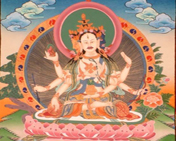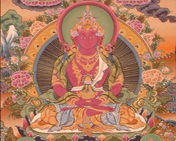Tibet Thangka
Buy Thangka Paintings in Tibet

Thangka is a uniquely Tibetan traditional art that evolved between the 7th and 12th centuries. Its origins lay in Indian religious art, but Nepalese, Chinese and Kashmiri styles also influenced its development. Painted on canvas and mounted in silk brocade, a thangka is more than just a work of art. It is an object of devotion, an aid to spiritual practice, and a bringer of blessings.
Thangkas come in a huge variety of styles, depicting various subjects. A thangka may portray the Buddha or some other deity, or a concept in Tibetan cosmology, astrology or medicine. The iconography of the thangka is rich in information about the spiritual practice of Buddhists and the Tibetan worldview. A thangka can help a mediator to learn and emulate the qualities of a particular deity, or to visualize his or her path towards enlightenment. It can bring blessings on the household and serves as a constant reminder of the Buddha's teachings of compassion, kindness and wisdom. Thangkas of particular deities may be used for protection or to overcome difficulties, such as sickness.

Thangka painting involves mastery of many demanding techniques: mastery in sketching the illustrations and numerous deities according to formal iconography rules laid down by generations of Tibetan masters; learning to grind and apply the paints, which are made from natural stone pigments; and learning to prepare and apply details in pure gold. From the canvas preparation and drawing of the subject, through to mixing and applying colors, decorating with gold, and mounting the finished work in brocade, the creation of a thangka painting involves skill and care at each stage and displays meticulous detail and exquisite artisanship.
A spiritual and religious expression as much as an art form, the process of learning to paint thangka is rigorous. In the first three years, students learn to sketch the Tibetan Buddhist deities using precise grids dictated by scripture. The two years following are devoted to the techniques of grinding and applying the mineral colors and pure gold used in the paintings. In the sixth year, students study in detail the religious texts and scriptures used for the subject matter of their work. To become an accomplished thangka painter, at least ten years training is required under the constant supervision of a master. After the training process, students still need five to ten years to become experts in the field.
Thangka painting requires extended concentration, attention to detail, and knowledge of Buddhist philosophy, and must be carried out in a peaceful environment.
Attractions you may also like:
Tibet Group Tour
-
12 Days Lhasa-EBC-Namtso-Nyingchi Group Tour from $1150
-
9 Days Classic Trip to EBC with Namtso Lake from $895
-
5 Days Lhasa-Namtso-Lhasa Group Tour from $568
-
7 Days Central Tibet Group Tour with Namtso from $712
-
4-Day Lhasa Join-in Group Tour from $356
-
5 Days Lhasa Group Tour with Yamdrok Lake from $530
-
5 Days Lhasa Pilgrimage Tour to Ganden Monastery & Drak Yerp from $530
-
6 Days Lhasa Shigatse Clssic Group Tour from $620
-
7 Days Overland Tour from Lhasa to Kathmandu from $780
- Lhasa Travel Guide
- Shigatse Travel Guide
- Nyingchi Travel Guide
- Ngari Travel Guide
- Lhokha Travel Guide
- Nagchu Travel Guide
- Chamdo Travel Guide
- Tibetan Culture
- Tibet Weather
- Tibet Map
- Tibet Tourism News